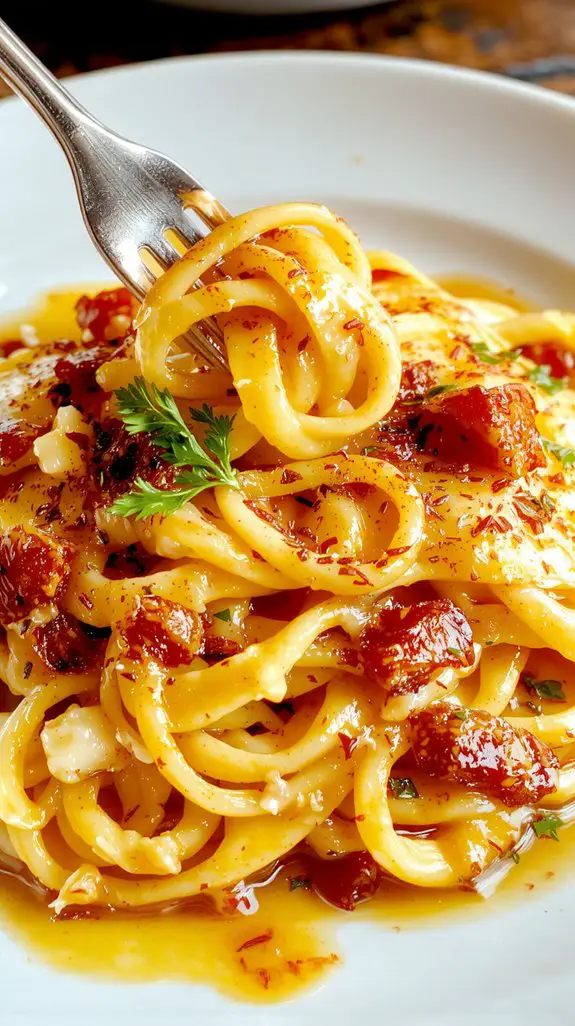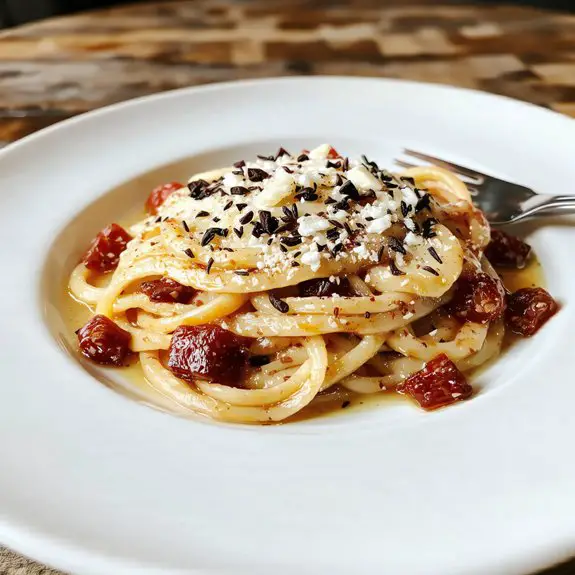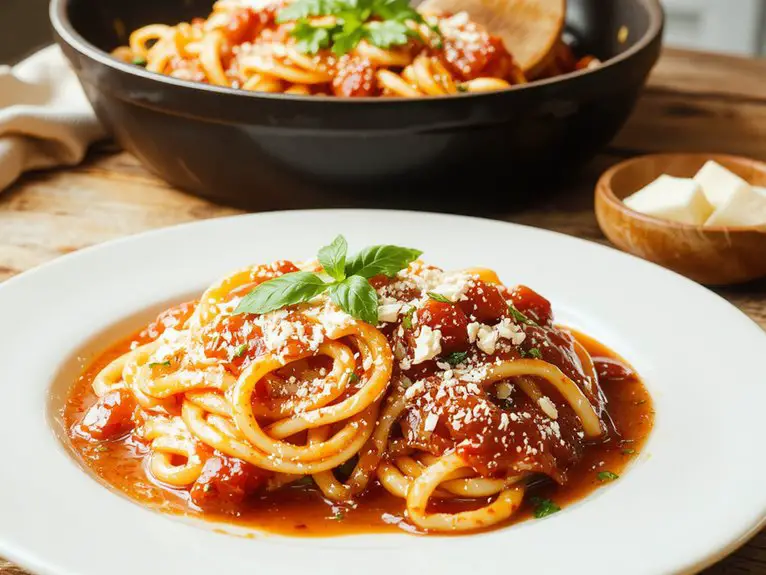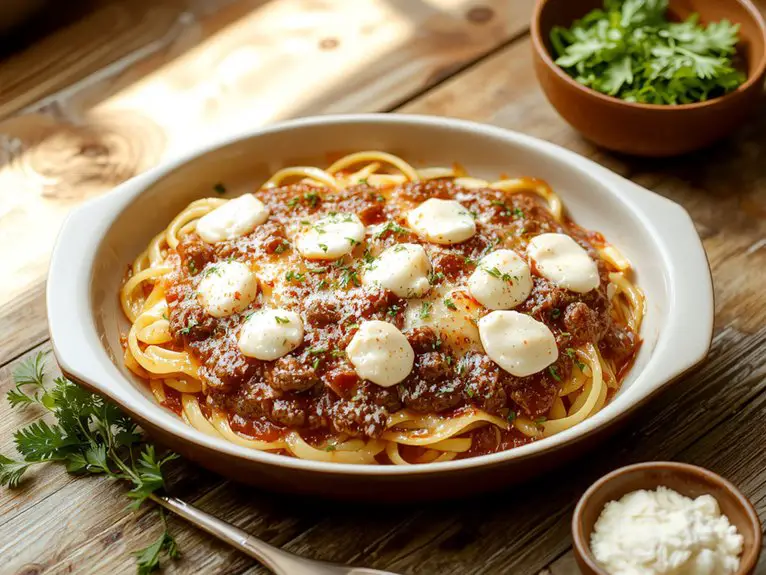Recipe
There’s a reason carbonara is a classic—when done right, it’s pure magic. This homemade version? It’s the real deal, with creamy, silky sauce clinging to every strand of pasta, salty bites of crispy pancetta, and just the right punch of black pepper to keep things interesting.
Forget the heavy cream—this recipe sticks to tradition, letting eggs, cheese, and starchy pasta water do all the work for a dish that’s rich but never cloying.
I’ve made this more times than I can count, tweaking it until it’s foolproof, and trust me, once you nail the technique, you’ll never go back to takeout.
The key? Timing, quality ingredients, and a little confidence—because you’ve totally got this. One bite, and you’ll understand why this is the carbonara recipe worth mastering.
Ingredients
Authentic carbonara hinges on the quality of its ingredients—each one plays a vital role in creating that creamy, indulgent sauce and rich flavor. Fresh, simple components are key, but don’t stress if you need to swap something out—this recipe is forgiving while still delivering that classic Roman taste.
Essential Ingredients:
- Pasta (Spaghetti or Bucatini): The star of the dish. Use high-quality pasta; its texture holds the sauce perfectly. Bucatini is traditional, but spaghetti works just as well.
- Guanciale (or Pancetta): Guanciale (cured pork jowl) is the OG choice for its rich, fatty flavor. If you can’t find it, pancetta is a solid substitute. Avoid bacon—it’s too smoky and will overpower the dish.
- Pecorino Romano Cheese: A non-negotiable. Its sharp, salty tang is what makes carbonara unique. Parmesan can be used in a pinch, but it won’t have the same bite.
- Eggs (Yolks Only for Extra Creaminess): Fresh, high-quality eggs are a must. For a richer sauce, use only yolks. Mixing in a whole egg can dilute the flavor slightly, but it’s still delicious.
- Black Pepper: Freshly cracked pepper is essential—it adds depth and a subtle heat. Don’t skimp on it!
Optional but Worth It:
- Pasta Water: The starchy water helps emulsify the sauce, making it silky smooth. Reserve at least a cup before draining your pasta.
- Parsley (for Garnish): A sprinkle of fresh parsley adds a pop of color and a hint of freshness, balancing the richness.
Pro Tip: Always use room-temperature eggs—they blend more smoothly into the sauce, preventing clumps.
And remember, no cream! True carbonara gets its creaminess from the egg and cheese mixture. Stick to the basics, and you’ll nail it every time.
How to Make the Best Authentic Carbonara Technique

Pro tip: Always work quickly when adding the egg mixture to prevent scrambling.
Watch-out warning: Avoid reheating carbonara—it’s best enjoyed fresh!
Nutrition
This homemade carbonara recipe is a classic Italian dish rich in flavor and nutrients. Below is the nutritional breakdown per serving based on standard ingredients.
| Nutrition | Amount |
|---|---|
| Calories | 580 |
| Protein | 22g |
| Carbohydrates | 45g |
| Fat | 32g |
| Saturated Fat | 15g |
| Cholesterol | 180mg |
| Sodium | 420mg |
| Fiber | 2g |
| Sugar | 3g |
Chef Tips
When I’m making carbonara, I always make sure the pasta water is well-salted—it’s the only chance to season the noodles themselves.
I use room-temperature eggs to avoid scrambling them when mixing with hot pasta.
Toss quickly off heat to create a creamy sauce without curdling. Reserve pasta water to adjust consistency.
Finish with freshly cracked pepper and grated Pecorino Romano for the best flavor.
Frequently Asked Questions
Can I Use Bacon Instead of Guanciale?
Yes, you can use bacon instead of guanciale—it’s more common and easier to find. I’ve done it before, and while the flavor’s slightly different, it still tastes great. Just crisp it up well for that perfect texture.
Is It Possible to Make Carbonara Without Eggs?
Yes, I can make carbonara without eggs, but it won’t be traditional. I’d use a creamy substitute like heavy cream or a vegan alternative, but the texture and flavor won’t match the classic egg-based version.
How Do I Store Leftover Carbonara?
I’d store leftover carbonara in an airtight container in the fridge for up to 2 days. Reheat it gently with a splash of water to keep it creamy—just don’t microwave it too long or it’ll dry out.
Can I Use Pre-Grated Parmesan Cheese?
I wouldn’t recommend pre-grated Parmesan; it’s often coated to prevent clumping, which keeps it from melting smoothly. Freshly grated cheese blends better and gives your carbonara that rich, creamy texture I’m sure you’re aiming for.
What Wine Pairs Best With Carbonara?
I’d pair carbonara with a crisp white wine like Pinot Grigio or a light Chardonnay—they cut through the richness. If you prefer red, go for a fruity, low-tannin option like a young Chianti.










